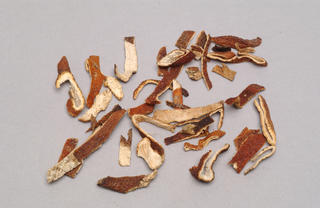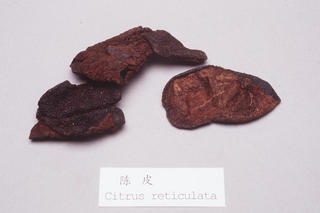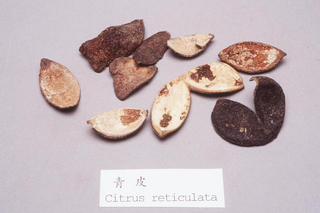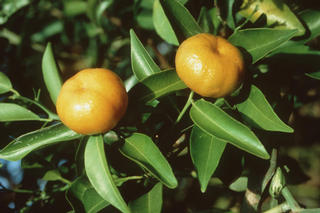Citrus reticulata
Contents
- 1 Nomenclature
- 2 Historical Use of Citrus reticulata
- 3 Background
- 4 Nomenclature
- 5 Historical Use of Citrus reticulata
- 6 Background
- 7 Nomenclature
- 8 Historical Use of Citrus reticulata
- 9 Background
- 10 Nomenclature
- 11 Historical Use of Citrus reticulata
- 12 Background
- 13 Nomenclature
- 14 Historical Use of Citrus reticulata
- 15 Background
- 16 Pharmaceutical Information
- 17 Evidence or the Use of Citrus reticulata in the Treatment of Epilepesy
- 18 Safety
Nomenclature
Other Names:
Historical Use of Citrus reticulata
Citrus reticulata in Traditional Chinese Medicine
Background
Chinese Name (pinyin): Juhong
Chinese Name :
Common Name :Red Tangerine Peel
Specific Name : Exocarpium citri rubrum
Scientific Name:
Collection : The ripe fruit is collected in late autumn and early winter, the exocarp is splited and collected, dried in the sun or in the shade.
Description : Long stripes or irregular thin slices, margin shrunken and curved inward. The outer surface yellowish brown or orange red, becoming dark brown on storage with numerous yellowish-white oil cavities. The inner surface yellowish white with numerous sunken and transparent small spots. Texture fragile, easily broken, odour aromatic, taste slightly bitter and numb.
Identification : 1.Powder: Pale yellowish brown, epidermal cells of the pericarp polygonal, subsquare or rectangular on surface view, anticlinal walls thickened, stomata subrounded, 18-26µm in diameter. Subsidiary cells indistinct, covered with cuticle in side view and the outer part of the radial walls thickened. The walls of parenchymatous cells surrounding the fragments of oil cavities slightly thickened.2.To 0.3g of the powder add 10ml of methanol, heat under reflux for 20 minutes, concentrate 5ml of the filtrate to 1ml as the test solution. Dissolve hesperidin CRS in methanol to produce a saturated solution as the reference solution. Carry out the method for thin layer chromatography (Appendix Vl B) using silica gel G as the coating substance and ethyl acetate-methanol-water (100:17:3) as the mobile phase. Apply separately 2µl of each of the two solution. After the developing (about 3cm) and removal of the plate, dry it in the air and then use tobelence-ethyl acetate-formic acid-water (20:10:1:1, supernatant) as the mobile phase, after developing (about 8cm) and removal of the plate, dry it in the air, spray with aluminum chloride, examine under ultra violet light (365nm). The fluorecescent spot in the chromatogram obtained with the test solution correspond in colour and position to spot in the chromatogram obtained with rerference solution.
Processing : Eliminate foreign matter, cut into slices.
Action : To dispel cold, eliminate damp and phlegm, and arrest emesis or nausea.
Indication : cough, itching of the throat and profuse expectoration in colds; nausea, vomiting and epigastric distendion caused by improper diet or excessive drinking
Precautions :
Dosage : 3 to 9 g.
Storage : Preserve in a cool and dry place, protected from moth.
Nomenclature
Other Names:
Historical Use of Citrus reticulata
Citrus reticulata in Traditional Chinese Medicine
Background
Chenpi ³ÂƤ
Guangchenpi ¹ã³ÂƤ
Guangpi ¹ãƤ
Xinhuipi лáƤ
Chinese Name (pinyin): Jupi
Chinese Name :
Common Name :Tangerine Peel
Specific Name : Pericarpium Citri Reticulatae
Scientific Name:
Collection :
Description :
Identification :
Processing :
Action :
Indication :
Precautions :
Dosage : 3-10g
Storage :
Nomenclature
Other Names:
Historical Use of Citrus reticulata
Citrus reticulata in Traditional Chinese Medicine
Background
Chinese Name (pinyin): Chenpi
Chinese Name :
Common Name :Dried tangerine peel
Specific Name : Pericarpium citri reticulatae
Scientific Name:
Collection : The drug is subdivided into two classes, known respectively as "Chenpi and "Guang Chenpi" The pericarp is peeled off when the fruit is ripe and dried in the sun or at low temperature.
Description : Chenpi; often peeled inseveral lobes connecting at the base or in irregular slices. 1 - 4mm thick. Outer surface orange red to reddish brown with fine wrinkles and sunken oil cavity spots, inner surface pale yellowish white, rough, bearing yellowish white or yellowish brown vein like vascular bundles. Texture slightly hard and fragile. Odour taste, pungent and bitter.Guang chenpi: Often in three lobes connected at the base, regular in shape and even in thickness, about 1mm thick when observed against light. Texture slightly soft.
Identification : 1.Powder: Yellowish white to yellowish brown. Parenchymatous cells of mesocarp numerous, cells irregular with unevenly thickened walls, sometimes beaded. Epidermal cells of pericarp polygonal, subsquare or rectangular in surface view, anticlinal walls, thickened stomata subrunded, 18 - 26µm in diameter, subsidiary cells indistinct, covered with cuticule in lateral view and theouter radial with thickened. Numerous prisms of calcium oxalate containing in parenchymatous cells of the mesocarp, polygonal, rhombicc or biconical. 3 - 34µm in diameter, 5 - 53µm long. Sometyimes two parallel polygonal crystals or 3 - 5 prisms occurring in one cell. Crystal of hesperidin mostly present in parenchymatous cells. Yellow or colorless in spheroid or amorphous masses, some crystals with radial striations. Spiral, pitted and reticulated vessels and tracheids small.2.To 0.3g of the powder add 10ml of methanol, heat under reflux for 20 minutes, filter. To 1ml of the filtrate, add a small quantity of magnesium powder and 1ml of hydrochloric acid, a red colour is produced gtradually.3.Concentrate 5ml of the filtrate obtained from identification (2) to about 1ml as the test solution. Prepare a saturated solution of hesperidin CRS in methanol as the reference solution. Carry out the method for thin layer chromatography (Appendix Vl B), using silica gel G with 0.5% solution of sodium hydroxide as the coating substance and ethyl acetate-methanol-water (100:17:13) as the mobile phase. Apply separately to the plate 2µl of each of the two soloutions. After developing for about 3cm and removal of the plate, dry it in the air. Using the upper layer of toluene-ethyl acetate-formic acid-water (20:10:1:1) as the mobile phase. After developing again about 8cm and removal of the plate, dry it in the air, Spray with aluminum chloride TS and examine under ultra violet light (365nm). The fluorescent spot in the chromatogram obtained with the test solution correspond in position and colour to the spot in the chromatogram obtained with the reference solution.Assay: Weigh accurately about 1g of the powder (through No.3 sieve) into a Soxlhlet extrctor [perform a determination of water (Appendix lX H, method 2)]. Add 100ml of petroleum ether (boiling range 30 - 60ºC), heat under reflux on a water bath for 1 hour and discard the petroleum ether solution. Add 120ml of methanol, heat under reflux on a water bath for 4 hours. Transfer the extract to an evaporating dish. Wash the container with small quantity of methanol, combine the washing with extract and evaporate the combined solution to dryness on a water bath. To the residue add 5ml of water, stir well, evaporate to dryness, treat once more in the same manner. Wash the residue with 5ml of water, stir well, allow it to stand for 10 minutes, filter through a Gooch crucible, wash the residue with 4 quantities of 5 ml of water and discard the washings. Dissolve the residue in 75% ethanol containing 0.1% of sodium hydroxide solution in portions, transfer the solution to 100 ml volumetric flask, add the above alkaline 1ml of the supernatant to a 25ml volumetric flask. Add the same alkaline ethanolic solution to volume and mix well. Carry out the method for spectrophotometry (Appendix V A). After 1 hour, counted from the beginning of dissolution of the residue, measure the absorbance at 362nm. 166 as the value of A(1%,1cm). It contains not less than 3.0% of hespiridin (C28H35O15) calculated on dried basis.
Processing : Eliminate foreign matter, spray with water, soften thoroughly, cut into slivers and dry in the shade.
Action : To regulate the flow of qi, to invigorate the spleen function, to eliminate damp, and to resolve phlegm.
Indication : distension and sensation of fullness in the chest and epigastrium with anorexia, vomiting and diarrhea; cough with copious phlegm
Precautions :
Dosage : 3 to 9 g.
Storage : Preserve in a cool and dry place, protected from mould and moth.
Nomenclature
Other Names:
Historical Use of Citrus reticulata
Citrus reticulata in Traditional Chinese Medicine
Background
Junqingpi ¾ùÇàƤ
Xiaoqingpi СÇàƤ
Chinese Name (pinyin): Qingpi
Chinese Name :
Common Name :Green Tangerine Orange Peel
Specific Name : Pericarpium citri reticulatae viride
Scientific Name:
Collection : The fallen young fruit is collected in May and June. Dried in the sun and known commonly as "Geqingpi". The immature fruit is collected in July and August, cut longitudinally into four valve but connected at the base, removed from the emergence completely and dried in the sun and known commonly as :Sihuaqingpi"
Description : Sihuaqingpi: Pericarp cut into four proteelliptic lobes, long elliptical, 4 - 6cm long, 0.1 - 0.2cm thick. The outer surface greyish green or blackish green with numerous oil cavities, the inner surface almost white or yellowish white, rough with yellowish white or yellowish brown veins. Texture slightly hard, easily broken, fracture showing 1 - 2 layers of oil cavities at the outer part. Odour aromatic, taste bitter and pungent.Geqingpi: Subspheroidal, 0.5 - 2cm in diameter, externally greyish green or blackish green, slightly rough with numerous fine and sunken oil cavities. Remains of style slightly projecting at the apex and a rounded scar of fruit stalk at the base. Texture hard, fractured pericarp yellowish white or pale yellowish brown. 1 - 2mm thick with 1 - 2 layers of oil cavities at the outer part. Pulp vescles 8 - 10, pale brown, odour delicately aromatic, taste sour, bitter and pungent.
Identification : 1.Sihuaqingpi powder: Greyish green or pale greyish brown. Parenchyma of mesocarp numerous, irregular, walls slightly thickened and some beaded. Epidermal cells of epicarp polygonal or subsquare in surface view, anticlinal walls thickened, stomata oblong, 20 - 28µm in diameter, subsidiary cells 5 - 7, covered with cuticle in lateral view. The outer radial walls slightly thickened. Prisms of calcium oxalate occurring in parenchymatous cells adjacent to the epidermis, polygonal, rhombic or square. 24 - 32µm long, crystal of hesperidin brownish yellow, hemispherical, subrounded or in irregular masses. Spiral and reticulated vessels small.Geqingpi: Epidermal cells of pulp vesicle narrowly prolate, thin walls, some sligtly sinous, containing prisms of calcium oxalate, similar to those of pericarp in size, also containing crystal of hesperidin.2.To 0.3g of the powder add 10 ml of methanol, heat under reflux for 20 minutes and filter. To 1ml of the filtrate add small amount of magnesium powder and several drops of hydrochloric acid, a cherry red colour is produced gradually.3.Take 5ml of the filtrate obtained under the test for Identification (2), concentrated to about 1ml as the test solution and a saturated solution of hesperidin CRS in methanol as the reference solution. Carry out the method for thin layer chromatography (Appendix Vl B), using silica gel G prepared with o.5% sodium hydroxide solution as the coating substance and ethyl acetate-methanol-water (100:17:13) as the mobile phase. Apply separately to the plate 2µl of each of the two solutions. After developing for about 3cm and removal of the plate, dry it in the air, and then using the upper layer of methylbenzene-ethyl acetate methanoic acid-water (20:10:1:1) as the mobile phase. After developing for about 8cm and removal of the plate, dry it in the air, spray with aluminum chloride TS. Examine under ultra violet light (365nm) after the methanol evaporated. The fluorescent spot in the chromatogram obtained with the test solution, correspond in position and colour to the spot in the chromatogram obtained with the reference solution.
Processing : Eliminate foreign matter, wash clean, soften thoroughly, cut into thick slices or slivers and dry in the sun.Processed with vinegar: Stir fry the slices and slivers as describe under the method for stir frying with vinegar (Appendix ll D) to slightly yellow, using 15kg of vinegar per 100 kg of Pericarpium Citri Reticulatae Viride.
Action : To soothe the liver, to disintegrate stagnated qi, and to remove retained food.
Indication : distending pain in the chest and costal regions; hernia; mass formation in the breast; mastitis; abdominal pain due to retention of undigested food
Precautions :
Dosage : 3 to 9 g.
Storage : Preserve in a cool and dry place.
Nomenclature
Other Names:
Historical Use of Citrus reticulata
Citrus reticulata in Traditional Chinese Medicine
Background
Chinese Name (pinyin): Juhe
Chinese Name :
Common Name :Tangerine Seed
Specific Name : Semen citri reticulatae
Scientific Name:
Collection : The drug is collected after the fruit is ripened, wash clean and dried in the sun.
Description : Slightly ovoid, 8 - 12 mm long, 4 - 6 mm in diameter. Externally pale yellowish white or pale greenish white, smoothy with raphe line on one side. One end obtuse rounded and the other end acuminate and small stalk shape. Testa thin, tenacious, endotesta thin, pale brown, 2 cotyledons, yellowish green, oily. Slight odor and bitter taste.
Identification : Transverse section: Epidermal cells of testa consisting of rows of mucilage cells with 1 row of palisade arranged sclerenchymatous cells underneath, outer walls even or with a tail like convex at the upper end, cell walls lignified, pitted and uneven in thickness, cells of pigment layer containing orange yellow or yellowish brown contents and prisms of calcium oxalate. 7 - 16µm in diameter, endosperm cells 3 - 4 rows, some cell walls beaded containing moil droplets. Cotyledon cells containing fine clusters of prism oxalate, oil droplets and rosette crystals of hesperidin.
Processing : Eliminate foreign matters, wash, clean and dry. Break into pieces before use.Processed with salt: Stir fry as describe under the method for stir frying with slat (Appendix ll D) to dryness and break into pieces before use.
Action : To regulate the flow of qi, cause subsidence of nodulation, and relieve pain.
Indication : hernia; painful swelling of the testis; mastitis with formation of painful nodules
Precautions :
Dosage : 3 to 9 g.
Storage : Preserve in a dry place, protected from mould and moth.
Synonymns for Citrus reticulata
Patent Medicines and Medicines with Multiple Ingredients that include Citrus reticulata
Pharmaceutical Information
Chemical Constituents
Evidence or the Use of Citrus reticulata in the Treatment of Epilepesy
Basic Science
Animal Studies
Cohort, Case-Control and Non-Randomized Trials
Randomized Controlled Trials
Meta-Analysis
1st Five Results: pubmed search
Xin Huang, Liyan Su, Baohang Xian, Qiyuan Yu, Miao Zhang, Jie Fan, Chenxi Zhang, Yiqi Liu, Houzheng He, Xin Zhong, Man Li, Shanchun Chen, Yongrui He, Qiang Li
Genome-wide identification and characterization of the sweet orange (Citrus sinensis) basic helix-loop-helix (bHLH) family reveals a role for CsbHLH085 as a regulator of citrus bacterial canker resistance.
Int J Biol Macromol: 2024;131442
[PubMed:38621573]
[WorldCat.org]
[DOI]
(I a)
Jinli Gong, Xuepeng Sun
Transient Expression Assay and Microscopic Observation in Kumquat Fruit.
Bio Protoc: 2024, 14(7);e4968
[PubMed:38618180]
[WorldCat.org]
[DOI]
(I e)
Xueli Sun, Chunhua Hu, Ganjun Yi, Xinxin Zhang
##Title##
Hortic Res: 2024, 11(4);uhae037
[PubMed:38617747]
[WorldCat.org]
[DOI]
(P e)
Nandang Permadi, Mohamad Nurzaman, Febri Doni, Euis Julaeha
##Title##
Saudi J Biol Sci: 2024, 31(6);103987
[PubMed:38617568]
[WorldCat.org]
[DOI]
(P p)
Eftychia Martinidou, Michail Michailidis, Vasileios Ziogas, Domenico Masuero, Andrea Angeli, Theodoros Moysiadis, Stefan Martens, Ioannis Ganopoulos, Athanassios Molassiotis, Eirini Sarrou
##Title##
J Agric Food Chem: 2024;
[PubMed:38613500]
[WorldCat.org]
[DOI]
(I a)



